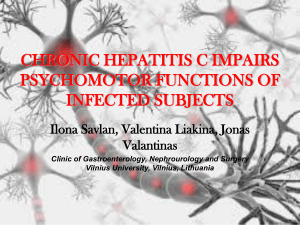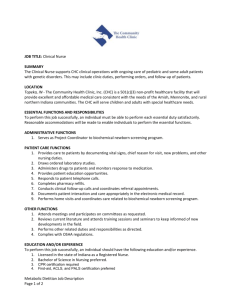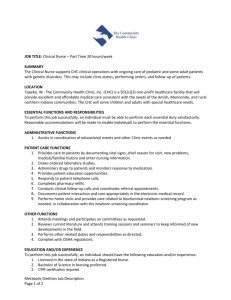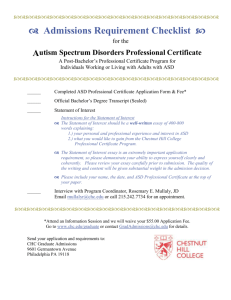CHC theory impact on IQ tests - Institute for Applied Psychometrics
advertisement
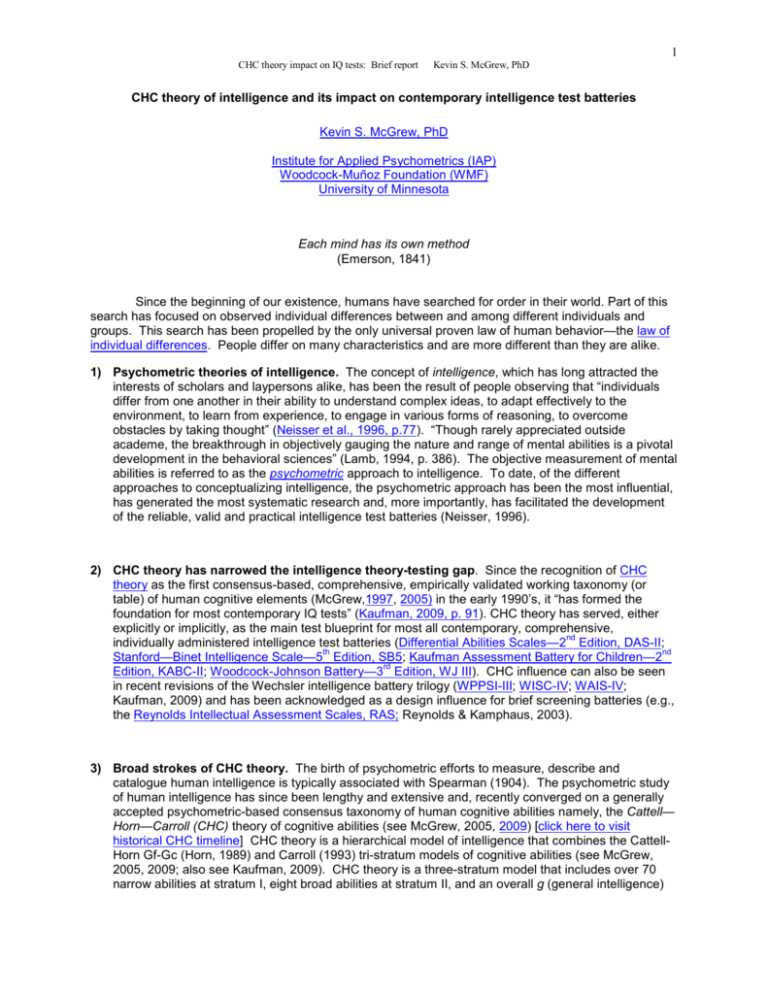
1 CHC theory impact on IQ tests: Brief report Kevin S. McGrew, PhD CHC theory of intelligence and its impact on contemporary intelligence test batteries Kevin S. McGrew, PhD Institute for Applied Psychometrics (IAP) Woodcock-Muñoz Foundation (WMF) University of Minnesota Each mind has its own method (Emerson, 1841) Since the beginning of our existence, humans have searched for order in their world. Part of this search has focused on observed individual differences between and among different individuals and groups. This search has been propelled by the only universal proven law of human behavior—the law of individual differences. People differ on many characteristics and are more different than they are alike. 1) Psychometric theories of intelligence. The concept of intelligence, which has long attracted the interests of scholars and laypersons alike, has been the result of people observing that “individuals differ from one another in their ability to understand complex ideas, to adapt effectively to the environment, to learn from experience, to engage in various forms of reasoning, to overcome obstacles by taking thought” (Neisser et al., 1996, p.77). “Though rarely appreciated outside academe, the breakthrough in objectively gauging the nature and range of mental abilities is a pivotal development in the behavioral sciences” (Lamb, 1994, p. 386). The objective measurement of mental abilities is referred to as the psychometric approach to intelligence. To date, of the different approaches to conceptualizing intelligence, the psychometric approach has been the most influential, has generated the most systematic research and, more importantly, has facilitated the development of the reliable, valid and practical intelligence test batteries (Neisser, 1996). 2) CHC theory has narrowed the intelligence theory-testing gap. Since the recognition of CHC theory as the first consensus-based, comprehensive, empirically validated working taxonomy (or table) of human cognitive elements (McGrew,1997, 2005) in the early 1990’s, it “has formed the foundation for most contemporary IQ tests” (Kaufman, 2009, p. 91). CHC theory has served, either explicitly or implicitly, as the main test blueprint for most all contemporary, comprehensive, nd individually administered intelligence test batteries (Differential Abilities Scales—2 Edition, DAS-II; th nd Stanford—Binet Intelligence Scale—5 Edition, SB5; Kaufman Assessment Battery for Children—2 rd Edition, KABC-II; Woodcock-Johnson Battery—3 Edition, WJ III). CHC influence can also be seen in recent revisions of the Wechsler intelligence battery trilogy (WPPSI-III; WISC-IV; WAIS-IV; Kaufman, 2009) and has been acknowledged as a design influence for brief screening batteries (e.g., the Reynolds Intellectual Assessment Scales, RAS; Reynolds & Kamphaus, 2003). 3) Broad strokes of CHC theory. The birth of psychometric efforts to measure, describe and catalogue human intelligence is typically associated with Spearman (1904). The psychometric study of human intelligence has since been lengthy and extensive and, recently converged on a generally accepted psychometric-based consensus taxonomy of human cognitive abilities namely, the Cattell— Horn—Carroll (CHC) theory of cognitive abilities (see McGrew, 2005, 2009) [click here to visit historical CHC timeline] CHC theory is a hierarchical model of intelligence that combines the CattellHorn Gf-Gc (Horn, 1989) and Carroll (1993) tri-stratum models of cognitive abilities (see McGrew, 2005, 2009; also see Kaufman, 2009). CHC theory is a three-stratum model that includes over 70 narrow abilities at stratum I, eight broad abilities at stratum II, and an overall g (general intelligence) 2 CHC theory impact on IQ tests: Brief report Kevin S. McGrew, PhD 1 ability at the apex of the hierarchy (stratum III). The model is the results of decades of psychometric research by many intelligence scholars, primarily via factor analytic (structural evidence) research. Support for the CHC structure is also based on neurocognitive, heritability (genetic), developmental, and prediction of differential outcomes evidence (Horn & Noll, 1997) [click here for brief definitions of these forms of construct evidence] 4) Broad CHC ability domains. Nine broad (stratum II) CHC ability domains are generally accepted as the hallmark feature of CHC theory, of which typically five to seven broad abilities are represented by 2 tests in contemporary intelligence batteries. Brief definitions of the nine primary broad CHC abilities 3 follow below: a. Fluid reasoning (Gf): The use of deliberate and controlled mental operations to solve novel problems that cannot be performed automatically. Inductive and deductive reasoning and logic are generally considered the hallmark indicators of Gf. Gf has been linked to the ability to handle greater degrees of cognitive complexity which is typically defined as more efficiency in processing a wider and diverse array of elementary cognitive processes (in active working memory) during cognitive performance. b. Comprehension-knowledge (Gc): A person's breadth and depth of acquired knowledge of the language, information and concepts of a culture, and/or the application of this knowledge. Gc is primarily a store of verbal or language-based declarative (knowing what) and procedural (knowing how) knowledge acquired through the investment of other abilities during formal and informal educational and general life experiences. c. Short-term memory (Gsm): The ability to apprehend and maintain awareness of a limited number of elements of information in the immediate situation (events that occurred in the last minute or so). A limited resource-capacity system that loses information quickly through the decay of memory traces, unless an individual activates other cognitive resources to maintain the information in immediate awareness. d. Visual-spatial processing (Gv): The ability to generate, store, retrieve, and transform visual images and sensations in the “mind’s eye.” Gv abilities are typically measured by tasks (viz., figural or geometric stimuli) that require the perception and transformation of visual shapes, forms, or images or tasks that require maintaining spatial orientation with regard to objects that may change or move through space. e. Auditory processing (Ga): Abilities that depend on sound as input and on the functioning of hearing. A key characteristic of Ga is the extent an individual can cognitively control (i.e., handle the competition between signal and noise) the perception of auditory information. The Ga domain circumscribes a wide range of abilities involved in the interpretation and organization of sounds, such as discriminating patterns in sounds and musical structure 1 John Horn (no g) and John Carroll (g exists) where in sharp disagreement regarding the validity of the construct of g. Horn felt it was a statistical artifact of the positive manifold of correlation matrices while Carroll believed it did represent some form of essential mental energy. This author had the privilege to participate in small private meetings (during the development of the WJ III and SB5 intelligence test batteries) with both Horn and Carroll and can attest to many “spirited” exchanges regarding the “g or not to g” disagreement between these two giants in the field of human intelligence. 2 Other broad domains that are relatively new to the CHC model, or which have not been deemed relevant to practical intelligence batteries, include decision and reaction speed (Gt), general (domain-specific) knowledge (Gkn), tactile abilities (Gh), kinesthetic abilities (Gk), olfactory abilities (Go), psychomotor abilities (Gp), and psychomotor speed (Gps). See McGrew (2009). 3 Space does not allow for a list (with definitions) of the 70+ narrow abilities that are subsumed under the broad CHC domains. See McGrew (2005) for the names and definitions of the various narrow CHC abilities. Click here for a more updated PDF copy. 3 CHC theory impact on IQ tests: Brief report Kevin S. McGrew, PhD (often under background noise and/or distorting conditions) and the ability to analyze, manipulate, comprehend and synthesize sound elements, groups of sounds, or sound patterns. f. Long-term storage and retrieval (Glr): The ability to store and consolidate new information in long-term memory and later fluently retrieve the stored information (e.g., concepts, ideas, items, names) through association. Memory consolidation and retrieval can be measured in terms of information stored for minutes, hours, weeks, or longer. Some Glr narrow abilities have been prominent in creativity research (e.g., production, ideational fluency, or associative fluency). g. Cognitive processing speed (Gs): The ability to automatically and fluently perform relatively easy or over-learned elementary cognitive tasks, especially when high mental efficiency (i.e., attention and focused concentration) is required over a sustained period of time. Typically measured by timed tasks. h. Reading and writing (Grw): The breadth and depth of a person’s acquired store of declarative and procedural reading and writing skills and knowledge. Grw includes both basic skills (e.g., reading and spelling of single words) and the ability to read and write complex connected discourse (e.g., reading comprehension and the ability to write a story). i. Quantitative knowledge (Gq): The breadth and depth of a person’s acquired store of declarative and procedural quantitative or numerical knowledge. Gq is largely acquired through the investment of other abilities primarily during formal educational experiences. Gq represents an individual's store of acquired mathematical knowledge, not reasoning with this knowledge. 5) Concluding comments and caveats: The connection between intelligence theorists and applied test developers has resulted in a small revolution in the field of applied intelligence testing. Most all comprehensive intelligence batteries implicitly or explicitly acknowledge the role of the CHC framework during test design. Yet, CHC theory should not be viewed as static. One should not succumb to the “hardening of the CHC categories” (McGrew, 2005, 2007) as new factor analytic research has already suggested possible modifications and revisions in the model. More importantly, a number of contemporary researchers are examining causal or dynamic CHC models (i.e., causal relations between CHC broad abilities), models that place the CHC structure within the framework of information processing theories, and research that seeks to understand the relations between CHC abilities and neurocognitive constructs and functioning. The CHC human ability taxonomy, although relatively new on the psychometric scene, should be considered just one major landmark accomplishment on the road to mapping the complete terrain of human cognitive performance. CHC has provided researchers and intelligence testing practitioners with a common nomenclature around which to frame and investigate research questions and issues. At this time the CHC taxonomy should be considered the first accurate starting point from which scholars of human intelligence can finally ground their research with an eye toward refining, extending, and/or fundamentally revising the CHC framework to eventually better describe and explain human cognitive performance. Carroll, J. B. (1993). Human cognitive abilities: A survey of factor analytic studies. New York: Cambridge University Press. Horn, J. L. (1989). Measurement of intellectual capabilities: A review of theory. In K. S. McGrew, J. K. Werder, & R. W. Woodcock (Eds), WJ-R technical manual (pp. 197- 245). Chicago, IL: Riverside. Horn, J. L., & Noll, J. (1997). Human cognitive capabilities: Gf-Gc theory. In D. P. Flanagan, J. L. Genshaft, & P. L. Harrison (Eds.), Contemporary intellectual assessment: Theories, tests and issues (pp. 53-91). New York: Guilford. Kaufman, A. S. (2009). IQ testing 101. New York: Springer Publishing. Lamb, K. (1994). Genetics and Spearmans’s “g” factor. Mankind Quarterly, 34(4), 379-391. 4 CHC theory impact on IQ tests: Brief report Kevin S. McGrew, PhD McGrew, K. S. (1997). Analysis of the major intelligence batteries according to a proposed comprehensive Gf-Gc framework. In D. P. Flanagan, J. L. Genshaft, & P. L. Harrison (Eds.), Contemporary intellectual assessment: Theories, tests, and issues (pp. 151-179). New York: Guilford. McGrew, K. S. (2005). The Cattell–Horn–Carroll theory of cognitive abilities. In D. P. Flanagan & P. L. Harrison (Eds.) Contemporary intellectual assessment: Theories, tests, and issues (2nd ed., pp. 136– 181). New York: Guilford Press. McGrew, K. (2009). Editorial: CHC theory and the human cognitive abilities project: Standing on the shoulders of the giants of psychometric intelligence research, Intelligence, 37, 1-10 Neisser, U., Boodoo, G., Bouchard, T. J., Jr., Boykin, A. W., Brody, N., Ceci, S. J., et al. (1996). Intelligence: Knowns and unknowns. American Psychologist, 51, 77-101. Reynolds, C. R., & Kamphaus, R. W. (2003). Reynolds Intellectual Assessment Scales: Professional manual. Lutz, FL: PAR.
